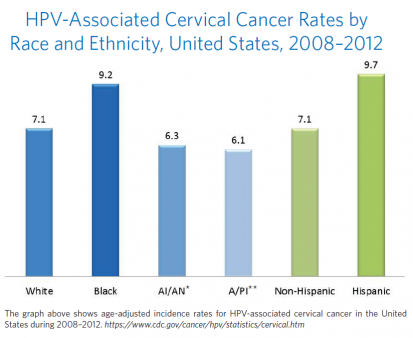Every year in the united states, approximately 12,000 women get cervical cancer and almost 4,000 women die from it. It is the most preventable female cancer with regular screening tests and early treatment.1
Cervical cancer is the leading cause of death in women in the United States.2

According to the CDC, for every 100,000 cases of cervical cancer, approximately 9 black women, 7 white women, 6 American Indian/Alaska Native women, and 6 Asian/Pacific Islander women were diagnosed with HPV-associated cervical cancer. Approximately 10 Hispanic women were diagnosed with HPV-associated cervical cancer per 100,000 women, compared to 7 non-Hispanic women.2
What Are the Risk Factors for Cervical Cancer?
Almost all cervical cancers are caused by human papillomavirus (HPV), a common virus that can be passed from one person to another during sex. There are many types of HPV. Some HPV types can cause changes on a woman’s cervix that can lead to cervical cancer over time, while other types can cause genital or skin warts.3
HPV can cause normal cells on your cervix to turn abnormal. Over time, abnormal cells can turn into cancer if they are not found and treated by your doctor. Cervical cancer often does not cause symptoms until it is advanced. Women with advanced cervical cancer may have abnormal bleeding, discharge, or pain.3
Other things which can increase your risk of cervical cancer:4
- Smoking.
- Having HIV or another condition that makes it hard for your body to fight off health problems.
- Using birth control pills for a long time (five or more years).
- Giving birth to three or more children.
- Having several sexual partners
What Women Should Know About Screening.
Cervical cancer is the easiest gynecologic cancer to prevent, with regular screening tests and follow-up. Two screening tests can help prevent cervical cancer or find it early:
- The Pap test (or Pap smear) looks for precancers, cell changes on the cervix that might become cervical cancer if they are not treated appropriately.
- The HPV test looks for the virus (human papillomavirus) that can cause these cell changes.
The Pap test is recommended for all women between the ages of 21 and 65 years old, and can be done in a doctor’s office or clinic.2
Diagnostic Laboratory of Oklahoma (DLO) can use the cells collected for the Pap to test for HPV, if requested by your provider.
In 2012, the American College of Obstetricians and Gynecologists (ACOG) announced its guidelines5 for cervical cancer testing using Pap screening.
- Most women should be screened for the first time at the age of 21.
- Most women younger than 30 should undergo cervical screening once every two years.
- Women age 30 and older can be re-screened once every three years.
These guidelines are for healthy women. Different screening schedules are recommended for women who have experienced abnormal Pap tests or other health conditions that may put them at greater risk for cervical cancer. Women should speak with their physician for more information about these guidelines and the best approach for their medical needs.
DLO is Oklahoma’s leading clinical diagnostic laboratory and does not provide medical advice, diagnosis, or treatment. Please see your health care provider for medical advice and care.
Resources
- Retrieved from https://www.cdc.gov/cancer/cervical/pdf/HPV_Testing_2012_English.pdf
- This study used cancer registry data to estimate the amount of HPV associated cancer in the United States by examining cancer in parts ofthe body and cancer cell types that are more likely to be caused by HPV.Cancer registries do not collect data on the presence or absence of HPV in cancer tissue at the time of diagnosis.
- National Center for Chronic Disease Prevention and Health Promotion.(2012) “Cervical cancer screening with the HPV test and the Pap test inwomen ages 30 and older”. Retrieved from www.cdc.gov/cancer.
- Retrieved from https://www.cdc.gov/cancer/cervical/basic_info/risk_factors.htm
- Retrieved from http://www.acog.org/About-ACOG/ACOG-Departments/Annual-Womens-Health-Care
Diagnostic Laboratory of Oklahoma (DLO) strives to empower patients to take a more active role in their healthcare decisions through providing education on disease states and available diagnostic testing, as well as resources for additional information from medical organizations.




CLIA